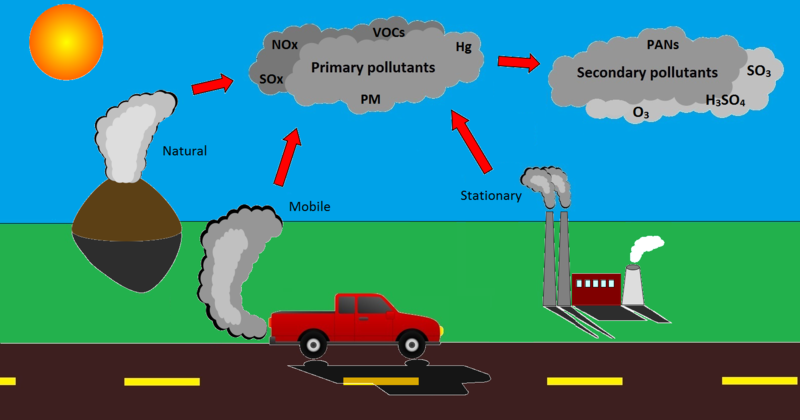Pollutant: Difference between revisions
J.williams (talk | contribs) m (1 revision imported) |
No edit summary |
||
| Line 1: | Line 1: | ||
[[category:371 topics]] | [[category:371 topics]] | ||
[[Category:Done 2015- | [[Category:Done 2015-09-06]] | ||
<onlyinclude>'''Pollutants''' are the [[element]]s, [[molecule]]s and [[particle]]s involved in [[pollution]] - life can be harmed when exposed to these materials, and the effects of them on humans and plants are well known.</onlyinclude> Pollutants can be introduced into the [[environment]] in many ways, both naturally and by humans. What pollutants do once they are emitted into the [[atmosphere]], soil or water supply is dependent on the type of pollutant, however it is useful to characterize them in the following way: '''[[Primary pollutant]]s''' are emitted directly into the environment, while '''[[secondary pollutant]]s''' are formed from primary pollutants and external factors.<ref name=hackett>G. Tyler Miller, Jr. and D. Hackett, "Outdoor Air Pollution," in ''Living in the Environment'', 2nd ed. USA: Nelson , 2011, ch.20, sec.2, pp.461-465</ref> | <onlyinclude>'''Pollutants''' are the [[element]]s, [[molecule]]s and [[particle]]s involved in [[pollution]] - life can be harmed when exposed to these materials, and the effects of them on humans and plants are well known.</onlyinclude> Pollutants can be introduced into the [[environment]] in many ways, both naturally and by humans. What pollutants do once they are emitted into the [[atmosphere]], soil or [[water]] supply is dependent on the type of pollutant, however it is useful to characterize them in the following way: '''[[Primary pollutant]]s''' are emitted directly into the environment, while '''[[secondary pollutant]]s''' are formed from primary pollutants and external factors.<ref name=hackett>G. Tyler Miller, Jr. and D. Hackett, "Outdoor Air Pollution," in ''Living in the Environment'', 2nd ed. USA: Nelson , 2011, ch.20, sec.2, pp.461-465</ref> | ||
Many pollutants are introduced into the environment in different ways, they have different and sometimes unique health effects and are found in different amounts. It is hard to briefly describe these for each chemical, however they can be read about on each pollutant's own page. Different types of pollutants include: | Many pollutants are introduced into the environment in different ways, they have different and sometimes unique health effects and are found in different amounts. It is hard to briefly describe these for each [[chemical]], however they can be read about on each pollutant's own page. Different types of pollutants include: | ||
*[[NOx|Nitrogen oxides]] (NOx) | *[[NOx|Nitrogen oxides]] (NOx) | ||
Revision as of 20:59, 3 September 2015
Pollutants are the elements, molecules and particles involved in pollution - life can be harmed when exposed to these materials, and the effects of them on humans and plants are well known. Pollutants can be introduced into the environment in many ways, both naturally and by humans. What pollutants do once they are emitted into the atmosphere, soil or water supply is dependent on the type of pollutant, however it is useful to characterize them in the following way: Primary pollutants are emitted directly into the environment, while secondary pollutants are formed from primary pollutants and external factors.[1]
Many pollutants are introduced into the environment in different ways, they have different and sometimes unique health effects and are found in different amounts. It is hard to briefly describe these for each chemical, however they can be read about on each pollutant's own page. Different types of pollutants include:
- Nitrogen oxides (NOx)
- Sulfur oxides (SOx)
- Particulate matter (PM)
- Ground level ozone (O3)
- Volatile organic compounds (VOCs)
- Mercury (Hg)
- Peroxyacyl nitrates (PANs)
- and more

References
- ↑ G. Tyler Miller, Jr. and D. Hackett, "Outdoor Air Pollution," in Living in the Environment, 2nd ed. USA: Nelson , 2011, ch.20, sec.2, pp.461-465
- ↑ Adapted from Living In The Environment: G. Tyler Miller, Jr. and D. Hackett, "Outdoor Air Pollution," in Living in the Environment, 2nd ed. USA: Nelson , 2011, ch.20, sec.2, pp.461-465.

